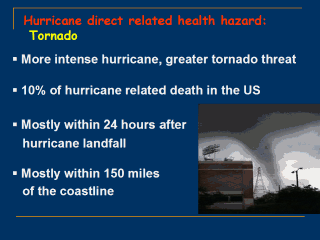 |
When a hurricane brings its winds inland, the
fast-moving air hits terrain and structures, causing a frictional
convergence which enhances lifting. Frictional convergence may be at least a
contributing factor to tornado formation in hurricanes. The greatest
concentration of tornadoes occurs in the right front quadrant of the
hurricane. A number of theories exist about their origin, but in the case of
Hurricane Andrew, severe damage was inflicted by small spin-up vortices that
developed in regions of strong wind-shear found in the hurricane's the eye
wall. The strong damaging winds of the hurricane frequently cover the
smaller tornado paths, making the separation of their damaging effects very
difficult.
|
